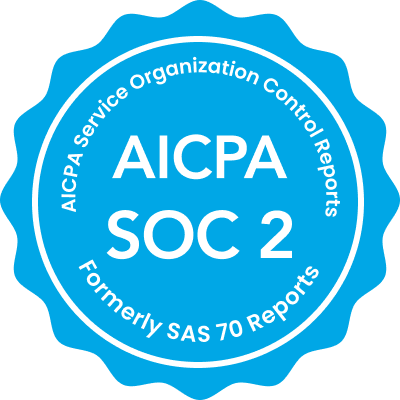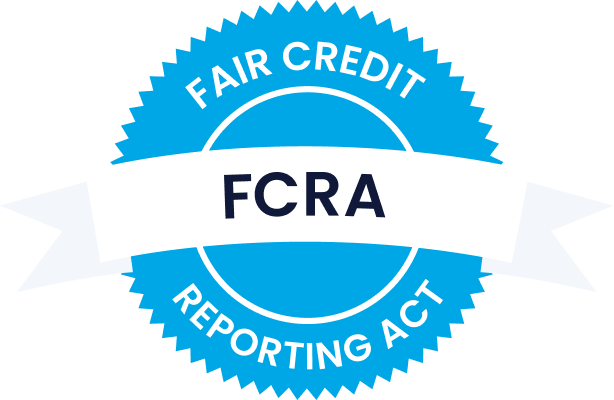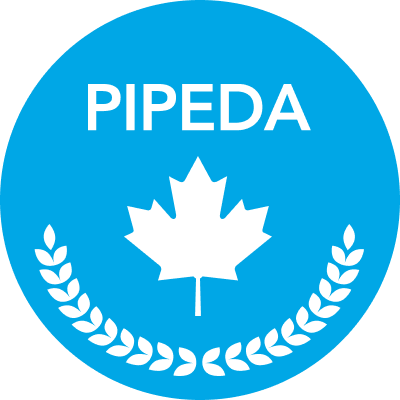Signing a lease agreement with a tenant based on false or misleading information can lead to disaster for your rental business: lost rental income, property damage, and costly evictions are all possible. For these reasons, knowing how to identify a fake rental application is a crucial skill you need to master as a landlord.
How common is tenant fraud?
Unfortunately, tenant fraud cases involving fake application documents are all too common in Canada.
In the Greater Toronto Area, eleven landlords accepted a tenant who later turned their rentals into illegal rooming houses. The tenant, now facing 11 fraud-related charges, allegedly provided fake identification on his rental applications. As a result, the landlords who searched his name online to verify vital details found no evidence of past wrongdoings. But if they had used his real name, they would have discovered a history rife with fraud-related charges.
Similarly, a Toronto landlord rented out his condo to two women who seemed like the ideal tenants. Both supplied him with what appeared to be credible documents as part of their rental application. However, the tenants did not pay their rent upon signing the lease agreement and refused the landlord’s requests to enter and inspect his condo. Upon further review of the tenants’ application documents, the landlord discovered much of the information they supplied was false or misleading.
Below is a survey from members of Small Landlords of Ontario (SOLO) that further illustrates the issue with fraudulent rental applications:
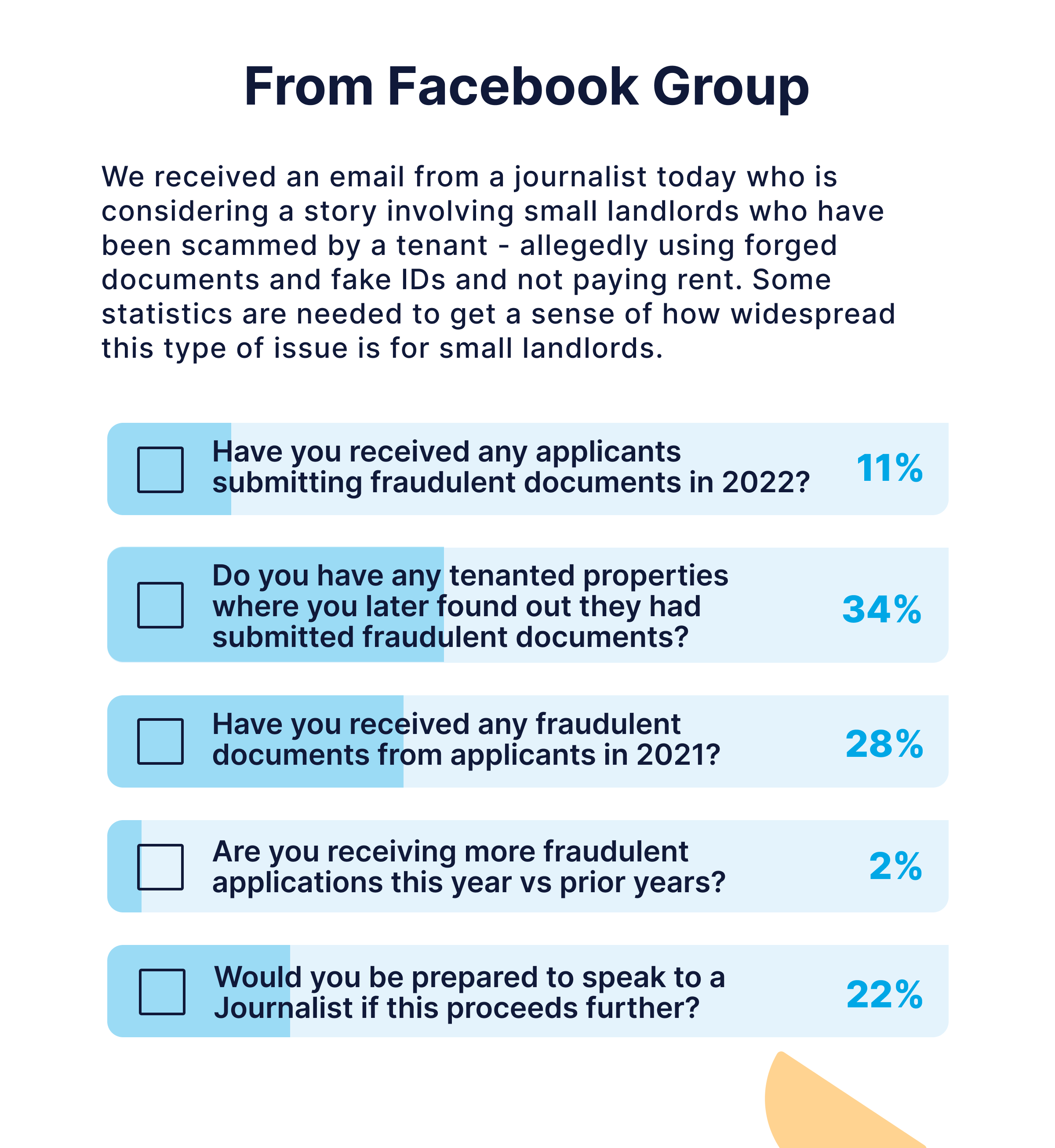
Given the prevalence of tenant scams in Canada, it’s essential to have systems in place to detect them. In this article, we’ll cover some valuable tips to help you identify fraudulent rental documents, as well as ways to screen a tenant effectively using objective, credible, and reliable sources.
Common rental application documents that tenants fake
Rental application documents can be modified or forged. Here are the most common and how to spot a fake.
Credit report
A tenant can modify their credit report by copying images from sample reports found online and merging them with their own report. They can also adjust the document as needed using software programs like Microsoft Word, Google Docs, and Acrobat DC.
When reviewing a credit report, keep an eye out for the following features, which may indicate that the document has been modified:
- Inconsistency with the font
- Details like address and name that aren’t consistent with information found on other documentation the tenant provides
- Max limits, late payments, number of loans, monthly payments, and other financial details that don’t add up
- Glaring spelling, grammar, and punctuation errors
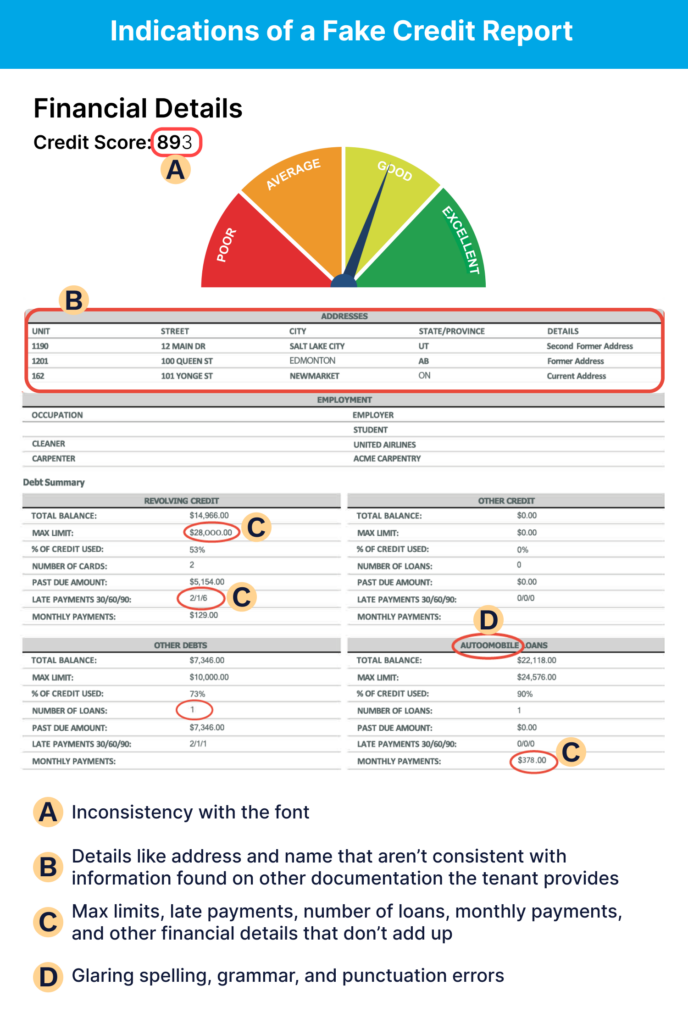
Other features to note on a credit report include:
- Missing pages
- Cut-off pages
- Page numbers that are in the wrong order
When reviewing a PDF copy of a credit report, try the following tactic to check if the document has been altered:
- Open the document and click on “File,” and then select “Properties”
- Click the “Document Properties” tab
- Examine the date and time to see if someone has modified the document since it was first created
Sometimes it can be extremely difficult to determine whether a credit report is legitimate. For this reason, purchasing a credit report from a reputable third-party source is the best way to ensure you don’t get scammed. It’s never wise to accept a credit report from a tenant directly.
SingleKey offers a tenant credit report and background check that can be ready to download in five minutes.
Pay stub
Numerous online applications allow tenants to create fake pay stubs. Usually, they offer a pre-made pay stub template, allowing the tenant to enter their address, company name, salary/hourly wage, pay date, and other details. They also calculate source deductions and other payroll data, which helps to make the pay stub look more authentic.
Here are some features that may indicate a fake pay stub:
- The letter “O” is used instead of a zero
- Glaring spelling, grammar, and punctuation errors
- Missing information, such as no company logo
- Net pay is a whole number, like $2,100, which after accounting for deductions, is unlikely
- Inconsistent, unusual, or blurry font
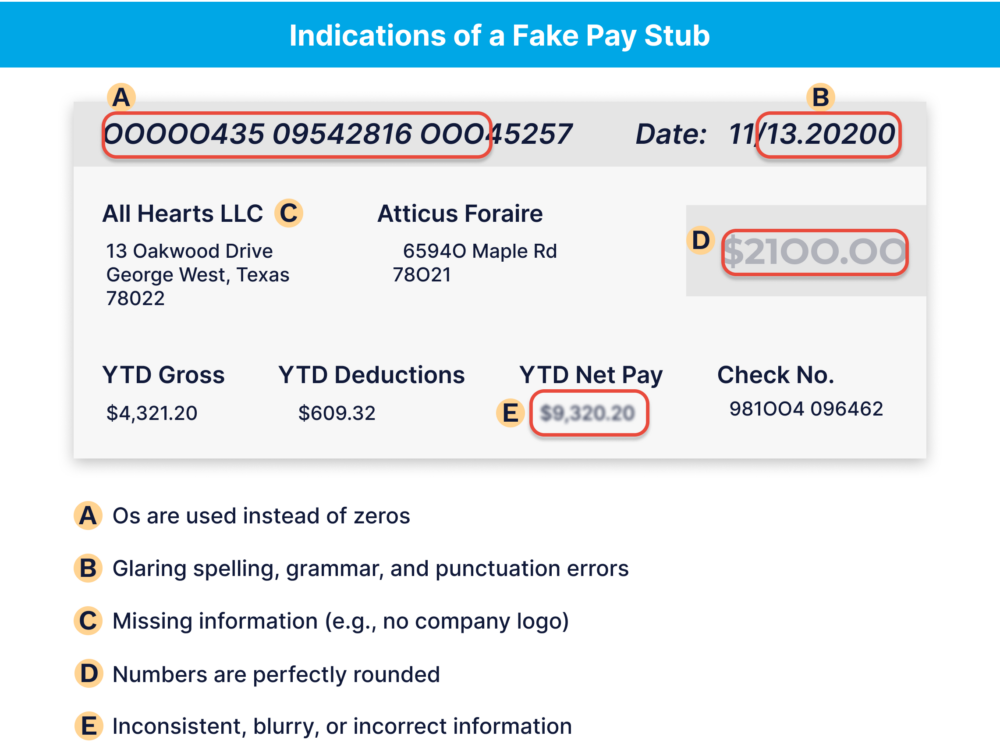
Other features of a potentially doctored bank statement include:
- Lack of details commonly found on pay stubs, such as the employer’s address
- Incorrect math. For example, the net pay is too high relative to gross pay
- Misaligned writing or numbers
- Details on the stub don’t match what’s found on other documentation provided by the tenant
Even with the clues above, it’s not always easy to identify a fraudulent pay stub. Therefore, it’s worth contacting the employer listed on the stub to confirm the applicant is a current employee. You can also ask the tenant to supply a recent bank statement to check if the earnings noted on their stub match their deposits.
As with a credit report, the best way to check whether a pay stub is genuine is by obtaining a credit and background report from a third-party source.
Bank statement
A bank statement can help you verify a tenant’s income and showcase their spending patterns. Unfortunately, it’s also prone to falsification.
Here are some signs that may indicate a phony bank statement:
- Bank logo and other trademarked symbols don’t match what’s on the bank’s website
- Inconsistent font type and size
- Sloppy spacing and alignment of numbers, text, and other elements
- Incorrect math. For example, the beginning balance from one statement doesn’t match the ending balance for another
- A large number of transactions with round numbers
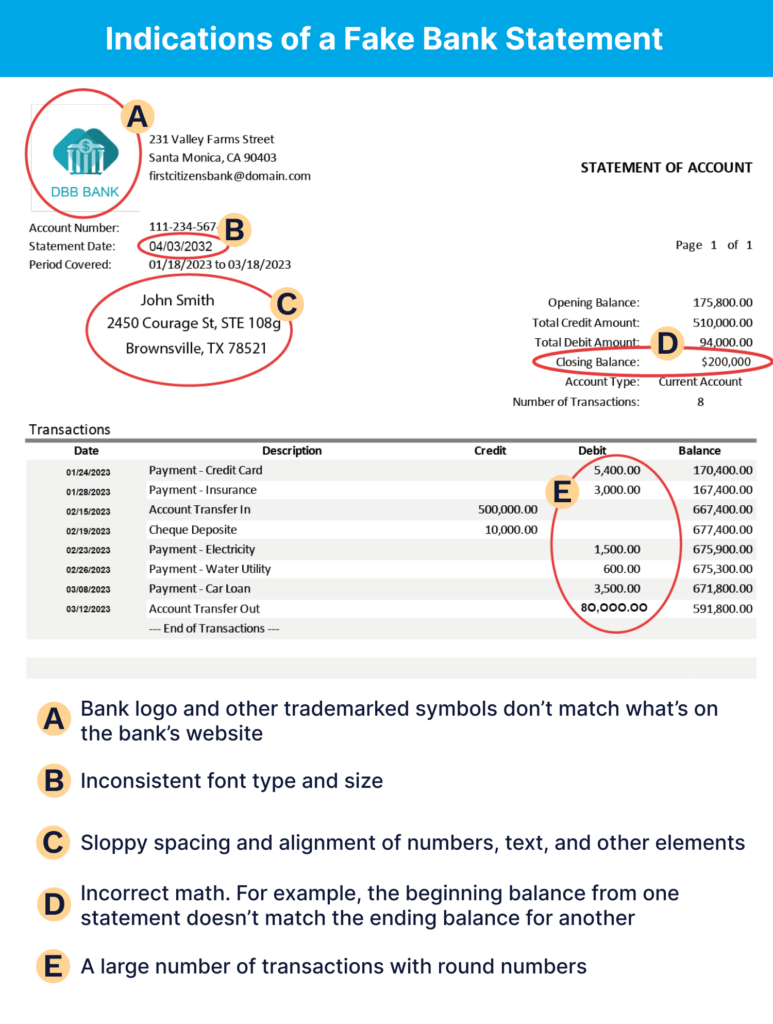
Ask the applicant to submit bank statements from the most recent 90 days. Three months of statements will provide solid insight into their spending habits and earnings.
Examine the statements for suspicious deposits and withdrawals and pay attention to any inconsistent transactions. Is there an abundance of transactions but no bank fees charged? Are there overdraft fees despite a high positive cash balance? Be sure to reconcile the transactions to confirm that the totals match the balance on the statement.
Also, compare the information in the bank statements with the details provided in the rental application form: it should be consistent. Then, do the same cross-examination with the pay stub.
Driver’s license
A driver’s license is one of the most common pieces of government-issued ID tenants will present to you. As with paper documents, a tenant can obtain a replica of the driver’s license issued in their jurisdiction. These fake cards contain features like holograms, laser print photos, embossment, micro print, and scannable barcodes that make them almost indistinguishable from the real thing.
In addition to checking these features, are there other clues you can look for to determine whether a driver’s license is genuine? Yes, but you must be able to examine the ID in your hands. Here are two tips:
- Examine the thickness of the photos. If it’s thicker than the immediate surrounding area, someone may have placed a second photo on top of the original.
- Assess the consistency between the numbers and letters. If the colour or thickness of some characters differs from the others, someone may have done a modification.
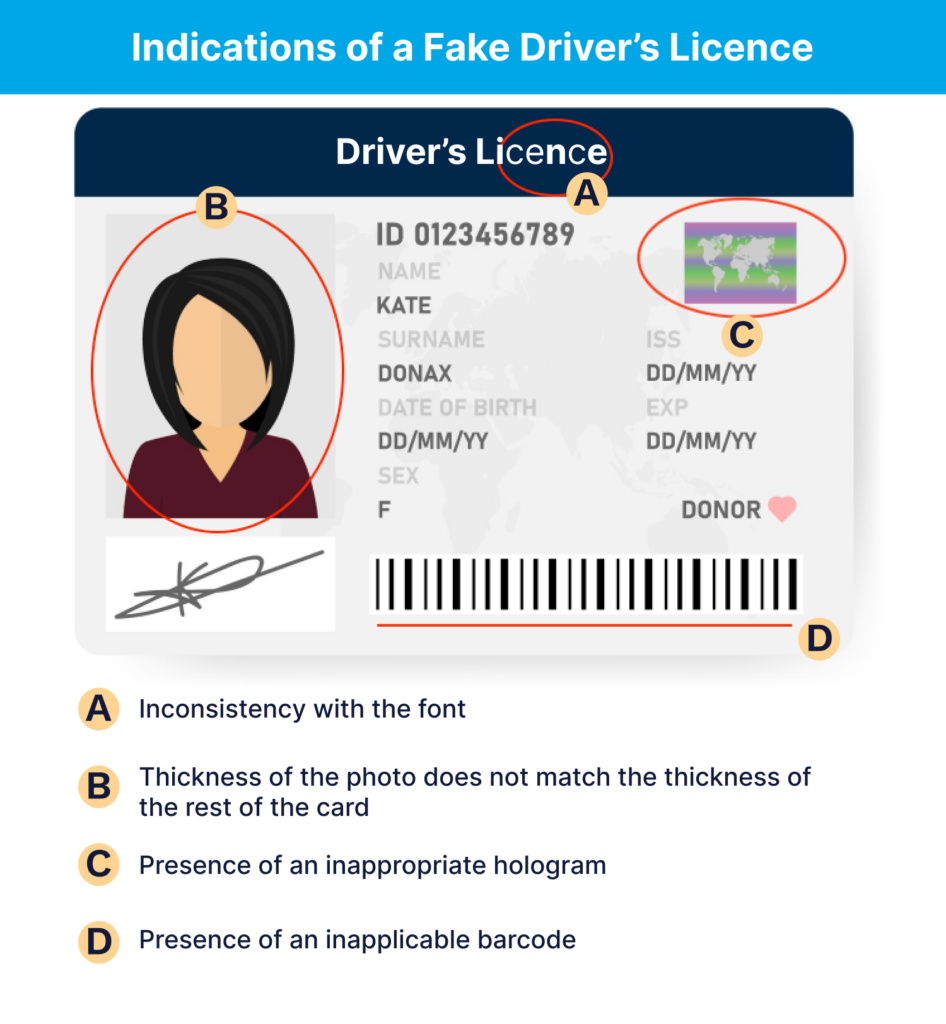
It also helps to become familiar with the various security features unique to licences issued in your province. You can then quickly spot any anomalies this way. For example, a driver’s licence from Ontario contains special inks visible only under ultraviolet light, as well as raised lettering on the driver’s license number and date of birth.
Additional steps for uncovering fraudulent rental applications
Fake rental applications created in a rush will contain many red flags and easily stand out. However, others may look remarkably genuine, so there’s still the risk of letting a fraudulent tenant slip through the cracks. Below are some additional measures you can employ to identify a tenant rental scam:
Use an online rental application service
Online rental application services allow you to create a standardized form that renters can fill out and submit to you through a secure portal. These platforms facilitate a faster turnaround, eliminate paperwork, and help you stay organized as you search for your ideal tenant.
In addition, they can act as the first line of defence against fraudulent applications. Some rental application service providers offer features that instantly detect suspicious applications. As a result, they can save you plenty of time and effort in weeding out dishonest tenants.
Rental applications you receive online are more susceptible to fraud than those submitted physically. For this reason, it’s always worth finding a reputable and reliable online rental application service if you’re taking the digital route.
Implement strict screening procedures
The more thorough your screening method, the more likely you’re to identify a tenant who knowingly tries to submit false information with their rental application. Try the following tactics to help you spot dishonest tenants:
- Conduct a complete background check, including a criminal record check and eviction history check.
- Review their rental history to see how often they switch residences.
- Check their social media profiles. If they lack an online presence, that’s a potential red flag. They may be using a fake name along with fraudulent identification.
- Never look past crucial omissions on rental applications. Inquire with the tenant as to why certain sections were left blank. If they’re reluctant to provide the necessary details, that’s a red flag.
- Always contact a tenant’s references, primarily past landlords and employers to confirm their validity. Instead of using the contact details provided by the tenant, do an online search to find the direct contact information for past landlords and employers.
- Conduct an in-person interview and assess how they respond (or don’t) to certain questions. Probe further by asking specific questions that relate to their current employment and rental history beyond what they provided in their application form.
Hire a professional property management firm
Does the prospect of evaluating rental applications for signs of fraud sound overwhelming? If so, consider hiring a property management company that specializes in tenant screening. As experts in their field, they have the knowledge and resources to identify and prevent rental application fraud.
Our final thoughts
Reviewing rental application documents for signs of fraud is essential if you’re in the rental business. Otherwise, you risk getting stuck with a tenant who doesn’t pay rent, causes property damage, or engages in criminal activity in your rental.
Fraudulent documents in rental applications are common. Remain vigilant when assessing PDF files, ID cards, and any piece of paper that comes your way.
At SingleKey, we understand how vital reliable financial and background tenant information is to landlords. Our comprehensive Tenant Report provides you with everything you need to decide whether to approve or decline an application.



